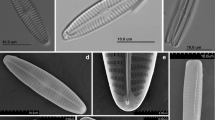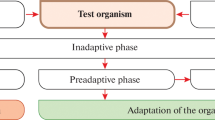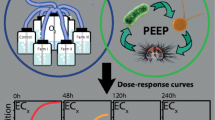Abstract
In the UK Direct Toxicity Assessment Programme, carried out in 1998-2000, a series of internationally recognised short-term toxicity test methods for algae, invertebrates and fishes, and rapid methods (ECLOX and Microtox) were used extensively. Abbreviated versions of conventional tests (algal growth inhibition tests, Daphnia magna immobilisation test and the oyster embryo-larval development test) were valuable for toxicity screening of effluent discharges and the identification of causes and sources of toxicity. Rapid methods based on chemiluminescence and bioluminescence were not generally useful in this programme, but may have a role where the rapid test has been shown to be an acceptable surrogate for a standardised test method. A range of quality assurance and control measures were identified. Requirements for quality control/assurance are most stringent when deriving data for characterising the toxic hazards of effluents and monitoring compliance against a toxicity reduction target. Lower quality control/assurance requirements can be applied to discharge screening and the identification of causes and sources of toxicity.
Similar content being viewed by others
References
Environment Agency (1998). Draft Short-term Ecotoxicological Methods Guidelines for Effluent and Receiving Water Assessment. Environment Agency, Bristol, UK.
Environment Agency (1999). A Proposed Scheme to Ensure the Quality of Data Generated by Laboratories Undertaking Regulatory Ecotoxicological Testing. R&D Technical Report P166, Environment Agency, Bristol, UK.
Environment Agency (2002a). Ecotoxicity Test Methods for Effluent and Receiving Water Assessment-Comprehensive Guidance. Environment Agency, Bristol, UK.
Environment Agency (2002b). Ecotoxicity Test Methods for Effluent and Receiving Water Assessment-Supplementary Advice to International Test Guidelines. Environment Agency, Bristol, UK.
Environment Canada (1999). Guidance Document on Application and Interpretation of Single-Species Tests in Environmental Toxicology. Report EPS1/RM/34. Method Development and Application Section. Environmental Toxicology Section, Environment Canada.
Girling, A.E., Riddle, A.M., Mitchell, G.M., Chown. P., Tinsley, D., Buckler, C., Johnson, I. and Benstead, R. (2004). Estimating Spatial Patterns of Effluent Exposure Concentrations in Direct Toxicity Assessment Studies, Ecotoxicology 13, 449–61.
Hutchings, M., Johnson, I., Hayes, E., Girling, A., Thain, J., Thomas, K., Benstead, R., Whale, G., Wordon, J., Maddox, R. and Chown. P. (2004). Toxicity Reduction Evaluation, Toxicity Identification Evaluation and Toxicity Tracking in Direct Toxicity Assessment. Ecotoxicology 13,475–84.
UKWIR (2001a). UK Direct Toxicity Assessment (DTA) Demonstration Programme-River Esk Project. Technical Report 00/TX/02/02. United Kingdom Water Industry Research, London, UK.
UKWIR (2001b). UK Direct Toxicity Assessment (DTA) Demonstration Programme-Lower Tees Estuary Project Part I. Technical Report 00/TX/02/03. United Kingdom Water Industry Research, London, UK.
UKWIR (2001c). UK Direct Toxicity Assessment (DTA) Demonstration Programme-Lower Tees Estuary Project Part II. Technical Report 00/TX/02/04. United Kingdom Water Industry Research, London, UK.
UKWIR (2001d). Technical Guidance for the Implementation of Direct Toxicity Assessment (DTA) for Effluent Control: Addressing Water Quality Problems in Catchments where Acute Toxicity is an Issue. Technical Report 00/TX/02/07. United Kingdom Water Industry Research, London, UK.
Umweltbundesamt (1997). Report on The OSPAR Workshop on Ecotoxicological Evaluation of Waste Water. Berlin, September 23-24, 1997.
US EPA (1991). Technical Support Document for Water Quality-based Toxics Control. Report EPA/505/2-90-001.Office of Water, United States Environmental Protection Agency.
Whitehouse, P., van Dijk, P.A.H., Delaney, P.J., Roddie, B.D., Redshaw, C.J. and Turner, C. (1996) The precision of aquatic toxicity tests: its implications for the control of effluents by Direct Toxicity Assessment. In J.F. Tapp, S.M. Hunt and J.R. Wharfe (eds). Toxic Impacts of Wastes on the Aquatic Environment, pp. 44–53, Royal Society of Chemistry.
Author information
Authors and Affiliations
Rights and permissions
About this article
Cite this article
Johnson, I., Hutchings, M., Benstead, R. et al. Bioassay Selection, Experimental Design and Quality Control/Assurance for Use in Effluent Assessment and Control. Ecotoxicology 13, 437–447 (2004). https://doi.org/10.1023/B:ECTX.0000035294.15964.9a
Issue Date:
DOI: https://doi.org/10.1023/B:ECTX.0000035294.15964.9a




